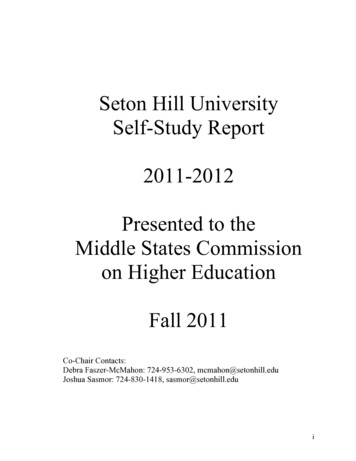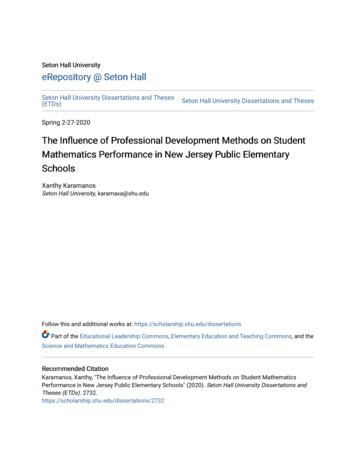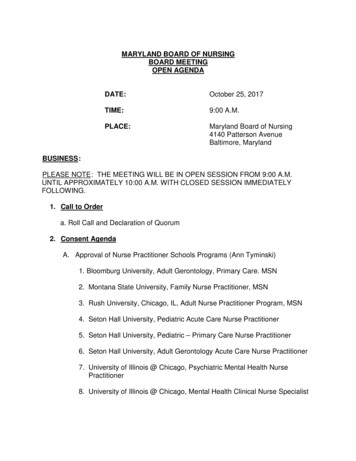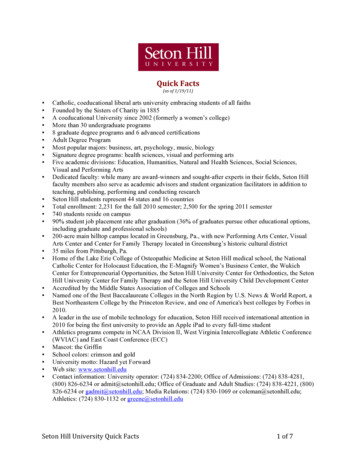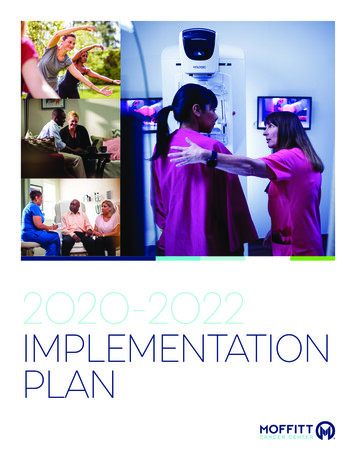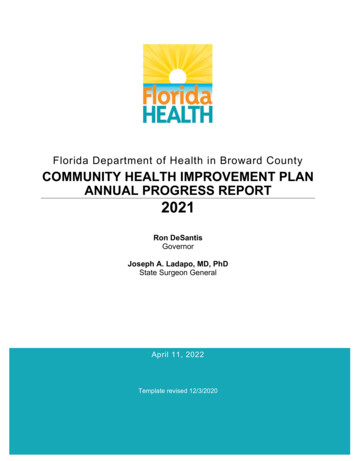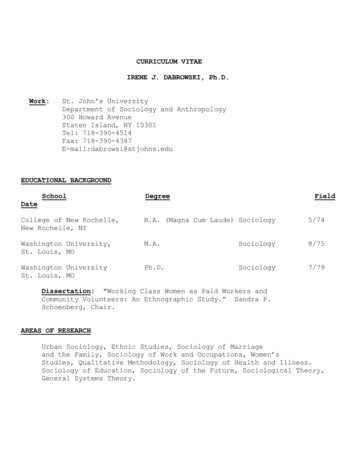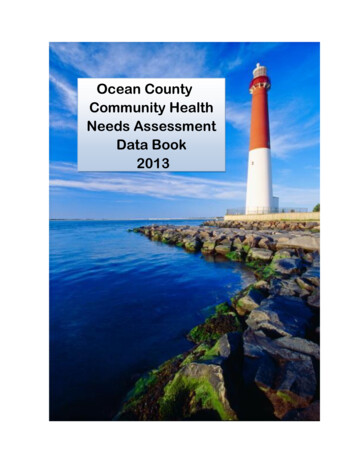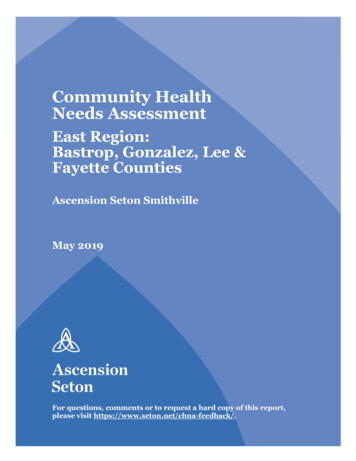
Transcription
Community HealthNeeds AssessmentEast Region:Bastrop, Gonzalez, Lee &Fayette CountiesAscension Seton SmithvilleMay 2019For questions, comments or to request a hard copy of this report,please visit https://www.seton.net/chna-feedback/.
Table of ContentsIntroduction .3Methodology .5Demographic Snapshot .7Community Health Needs . 10Mental Health . 11Access to Care . 12Chronic Diseases . 14Other Issues . 17Conclusion . 18Approval . 18Appendix One: County Health Rankings from Robert Wood Johnson Foundation and the University of WisconsinPopulation Health Institute . 19Appendix Two: Organizations Represented in Focus Groups and Interviews . 20Appendix Three: Summary of Community Health Resources . 22Appendix Four: Evaluation of Impact of Actions Since 2016 CHNA . 23Ascension Seton Smithville . 242 Ascension Seton CHNA East Region
IntroductionAscension Seton, formerly known as Seton Family of Hospitals, is a 501(c)(3) nonprofit organization with a longstanding history of serving Central Texas, not only as a health care provider, but as a leader and advocate forimproving the health of the population as a whole.Ascension Seton’s MissionRooted in the loving ministry of Jesus as healer, we commit ourselves to serving all persons with specialattention to those who are poor and vulnerable. Our Catholic health ministry is dedicated to spirituallycentered, holistic care which sustains and improves the health of individuals and communities. We areadvocates for a compassionate and just society through our actions and words.Ascension Seton’s philosophy is that “We serve each person as a Christian would serve Christ Himself. As acaring community, we respect the dignity and needs of one another.” Our values include the following:Dedication: Affirming the hope and joy of our ministryReverence: Respect and compassion for the dignity and diversity of lifeWisdom: Integrating excellence and stewardshipIntegrity: Inspiring trust through personal leadershipService to the Poor: Generosity of spirit, especially for the persons most in needCreativity: Courageous innovationWhat is a Community Health Needs Assessment?A Community Health Needs Assessment (CHNA) is a tool used to identify and prioritize health issues and developtargeted interventions to build healthier communities. A CHNA provides important information to policymakers,public health leaders, health care providers and the general public about the overall health status of acommunity and the unmet needs or challenges that warrant further attention and resources.This CHNA provides a snapshot of local health care needs in Ascension Seton’s East Region and helps informAscension Seton’s decisions about how to best serve the community.3 Ascension Seton CHNA East Region
Why do a Community Health Needs Assessment?A CHNA is used to gather diverse perspectives, mobilize resources and target those resources to areas ofgreatest need identified by the community and validated by data.The 2010 Patient Protection and Affordable Care Act further reinforced the importance of community healthneeds assessments by requiring hospitals designated as tax exempt 501(c)(3) nonprofit organizations tocomplete an assessment every three years.This CHNA is intended to meet the requirements for community benefit planning and reporting established in,but not limited to: Texas Health and Safety Code Chapter 311 and Internal Revenue Code Section 501(r).How did we define the community?This CHNA addresses the health care needs of Bastrop, Gonzales, Fayette and Lee counties, Ascension Seton’sEast Region. These four counties are the focus of this CHNA because they are part of Ascension Seton’s primaryservice area. Ascension Seton Smithville is an acute care facility located in the East Region, 13 miles east ofBastrop in Bastrop County.4 Ascension Seton CHNA East Region
MethodologyHow did we conduct this Community Health Needs Assessment?The Internal Revenue Service (IRS) allows local health care organizations to work together to avoid duplication ofeffort. In this spirit of collaboration, Ascension Seton and St. David’s Foundation (SDF) which both serve thisregion, shared information collected during the CHNA process and developed their own CHNA reports.The CHNA process included two distinct but connected phases of analysis.Phase One:During the first phase of the project, Ascension Seton gathered and analyzed the most recent quantitative dataavailable for the 4 counties located in the East Region. Ascension Seton used a Z-score methodology to comparethe four counties in the East Region to ten Central Texas counties, Texas, and the United States across 68different health measures. Z-scores are a way to standardize different types of data for comparison purposes.This process helped identify and prioritize major health care needs highlighted in this report.Phase Two:For the second phase of the project, Ascension Seton and SDF worked with an external consultant, SharedStrategy Group, to gather qualitative feedback from the broader West Region community using severalmethods, including focus groups and one-on-one stakeholder interviews using a standardized interview guide.Shared Strategy Group is a national consulting firm based led by Lolita Ross, MPPA, PMP, who previously servedas the Chief Program Officer for the National Network of Public Health Institutes. Shared Strategy Group hasextensive experience gathering stakeholder input from diverse communities and working with non-profitorganizations, government, and philanthropic organizations across the nation.The consulting team solicited input from individuals with a broad understanding of the community and its healthneeds. Key stakeholders included public health officials, individuals representing the interests of medicallyunderserved, low-income and minority populations, health care providers, educators, public officials and manyothers.5 Ascension Seton CHNA East Region
During the interviews and focus groups, participants were asked to identify the most significant health needsfacing their community, barriers to meeting those needs, gaps in service and potential opportunities forimproving health.On behalf of Ascension Seton and SDF, the consulting firm, Shared Strategy Group, conducted 10 key informantinterviews in August 2018 with representatives of organizations that represent the diverse economy and racialand ethnic interests of the region. Key informant interviews were conducted with Ascension SetonSmithville, Combined Community Action, Texas A&M AgriLife Extension Services, Veterans Affairs,Smithville Independent School District, Bluebonnet Trails, Bastrop Independent School District,Ascension Catholic Church and Lone Star Circle of Care.In addition to the interviews, Shared Strategy Group Health conducted five focus groups in Bastrop County inAugust 2018. Locations included the Lost Pine Elementary School, Bastrop Outreach Christian Center, ElginRecreational Center, the Smithville Free Clinic and Grace Baptist Church.For more information on interviews and focus groups, please consult Appendix Two.How were Community Health Needs Prioritized?Ascension Seton worked with a highly experienced local health care consultant, Management InformationAnalytics (MIA), to analyze the quantitative and qualitative data gathered during phases one and two of thisproject. Since 1990, the firm has worked with a wide range of health care clients, including the Community CareCollaborative in Austin and the South Texas Crisis Collaborative in San Antonio. MIA has worked with AscensionSeton on CHNAs since the early 1990’s and assisted with data collection and analysis for the 2016 CHNA report.This report synthesizes the findings from both the quantitative and qualitative phases of the community healthassessment process and identifies significant health care needs in the East Region where Ascension Seton, as amajor health care system, can have the most influence and impact.The prioritized needs that are described in the following report were either:(1) Raised consistently during focus groups, interviews and surveys as significant community concerns,(2) Identified in county-level health data as a glaring issue or6 Ascension Seton CHNA East Region
(3) Discussed by the community on some level and validated by county-level data.The proposed prioritized health needs were presented on February 1, 2019 and February 11, 2019 to theAscension Texas Executive Committee and President’s Council respectively for input and approval.The prioritized list of significant health needs was presented and approved by the hospital’s governing body andthe final CHNA is available on each of Ascension Seton hospital’s websites at www.seton.net.Demographic SnapshotBastrop County is growing more rapidly than the other three counties in the East Region. In 2018, Bastropcomprised 57 percent of the East Region’s total population, by 2030 is projected to have 60 percent of the Eastpopulation.East Region ource: Texas Demographic Center (demographics.texas.gov); data pulled May 2018With its suburban population, Bastrop is somewhat younger than the East Region overall. In 2018, 16 percent ofBastrop County’s population was over age 65, compared to 18 percent in the overall East Region and 20 percentin the three rural counties (Fayette, Gonzalez, Lee). By 2030, these figures are projected to be 21, 23 and 26percent respectively.7 Ascension Seton CHNA East Region
East Region Population by Age100%85 65-8480%45-6460%15-4440%20%0-140%20182030Source: Texas Demographic Center (demographics.texas.gov); data pulled May 2018Bastrop has a more diverse racial and ethnic makeup than the three rural counties. In 2018, Bastrop County was52 percent white, 38 percent Hispanic, 7 percent black. In comparison, the three rural counties were 58 percentwhite, 33 percent Hispanic and 7 percent black.East Region Population by 20%0%201020162018202020252030Source: Texas Demographic Center (demographics.texas.gov); data pulled May 2018As in the rest of Texas, the East Region is on track to become more diverse. By 2030, Bastrop isprojected to be 44 percent white, 46 percent Hispanic, and 7 percent black. The three rural countieswill be 53 percent white, 39 percent Hispanic and 7 percent black.8 Ascension Seton CHNA East Region
At 13.8 percent, the poverty rate in the East Region is below the state average of 16.7 and below thenational average of 15.1 percent.Poverty Rate, 2012-2016Percent of Population in Households With IncomeBelow 100% of Federal Poverty Level18%15%12%16.7%13.6%14.0%13.8%BastropOther EastEast Total15.1%9%6%3%0%TexasUSSource: Institute for People, Place and Possibility - Community Commons(communitycommons.org), data pulled June 2018The uninsured rate for adults is higher in the East Region (24.9 percent) and about the same as Texas (23.3percent), but nearly twice the national average of 13 percent. The uninsured rate for children is 13.1 percent inthe east region, which is considerably higher than the state average of 10 percent and the national average offive percent. The uninsured rate for children in the three rural counties that comprise the East Region is higher(14.1 percent), but lower in the more suburban Bastrop County (12.4 percent).9 Ascension Seton CHNA East Region
Health Insurance Coverage: Adults, 2015Percent of Adults Under Age 65 Without Health %0%BastropOther EastEast TotalTexasUSSource: RWJ Foundation/Univ of Wisconsin Institute County Health Rankings(countyhealthrankings.org); data pulled June 2018Health Insurance Coverage: Children, 2015Percent of Children Under Age 18Without Health %2%0%BastropOther EastEast TotalTexasUSSource: RWJ Foundation/Univ of Wisconsin Institute County Health Rankings(countyhealthrankings.org); data pulled June 2018Community Health NeedsAfter reviewing the data and community input and using the methodology outlined above, Ascension Setonidentified three main categories of health priorities for the East Region: (1) mental health, (2) access to care and(3) chronic diseases.10 Ascension Seton CHNA East Region
Mental HealthOne of the most consistent concerns raised during the focus groups and interviews was the need to improveaccess to mental health services in the East Region. Most key informants stated that mental health services are avital concern in the rural communities. Focus group members and key informants stated that it can take manymonths to secure an appointment with a psychiatrist or mental health provider. Community members alsomentioned several recent youth suicides and the opioid epidemic.The data clearly corroborate the concerns of the community, especially in terms of provider availability. At 45.3providers per 100,000 residents, the East Region is less than half the state average of 98.8 and eight times worsethan the national rate of 370.4 per 100,000 residentsMental Health Providers, 2017Providers per 100,000 Other EastEast Total98.80BastropTexasUSSource: RWJ Foundation/Univ of Wisconsin Institute County Health Rankings(countyhealthrankings.org); data pulled June 2018The number of poor mental health days in the East Region is slightly higher than the state average and slightlylower than the national average. The suicide rate in Bastrop County, on the other hand has increased and isworse than the state average. Collaborating these data is Bastrop, Lee and Fayette counties’ designations asHealth Professional Shortage Areas (HPSAs) for mental health by the Health Resources & ServicesAdministration. Bastrop is a suburban HPSA, Gonzalez is designated as a rural High Needs HPSA, and Lee andFayette as rural HPSAs.11 Ascension Seton CHNA East Region
Poor Mental Health Days, 2016Average in Past 30 days, Age-Adjusted43.833.63.7Other EastEast Total3.83.4210BastropTexasUSSource: RWJ Foundation/Univ of Wisconsin Institute County Health Rankings(countyhealthrankings.org); data pulled June 2018Suicide Mortality, 2012-2016Deaths per 100,000 Population, BastropOther EastEast TotalTexasUSSource: Institute for People, Place and Possibility - Community Commons(communitycommons.org), data pulled June 2018Access to CareBoth the focus groups and stakeholder interviews identified improving access to health care as a key communitypriority. Top concerns included expanding access to mental health care (including substance abuse and youthservices), women’s health services (including prenatal care) and dental care. Overall, community membersacknowledged the availability of many health care services in the region, but noted significant barriers to access,including, but not limited to: long wait times for appointments, limited clinic hours, local providers not accepting12 Ascension Seton CHNA East Region
new patients or forms of payment like Medicare or Medicaid, the location of healthcare services/clinics,difficulty finding transportation to appointments and fear of deportation.The quantitative data validates the concerns raised by community members. In addition to mental health HPSAsdescribed above, Bastrop is designated as a non-rural HPSA for primary care, Lee counties is designated as ruralHPSA for primary care, and Gonzalez and Fayette counties are designated as a Low-Income HPSAs for primarycare.Providers Per 100,000 ary CarePhysicians75.859.931.527.339.838.929.6Other Primary CareProviders81.366.835.633.839.852.717.6Mental l Dentists67.655.936.431.451.743.129.3Source: RWJ Foundation/Univ of Wisconsin Institute County Health Rankings(countyhealthrankings.org); data pulled June 2018Access to dental care is a challenge in the East Region with lower than state and national average access togeneral dentists, especially in the rural counties. The percent of adults reporting that they had no dental exam inthe past year was twice as high in Bastrop County (60.4 percent) as the national average (30.2 percent).13 Ascension Seton CHNA East Region
No Dental Exam In Past Year, 2006-2010Percent of Population Age 18 stropOther EastEast TotalTexasUSSource: Institute for People, Place and Possibility - Community Commons(communitycommons.org), data pulled June 2018Chronic DiseasesThe third priority area for the East Region is chronic disease prevention and management. Both focus groupmembers and key informants expressed concern about the prevalence of chronic diseases in the communitysuch as diabetes, obesity and hypertension.The quantitative data support the need to prioritize chronic disease prevention and management in the EastRegion. Diabetes prevalence in the East Region is slightly above the state and national average. However, whendata from the three rural counties (Lee, Gonzalez and Fayette) are isolated, diabetes prevalence is about twopercentage points higher than the state and national averages.14 Ascension Seton CHNA East Region
Diabetes Prevalence, 2014Percent of Population Age 20 With Diagnosed 10.0%TexasUS6%4%2%0%BastropOther EastEast TotalSource: RWJ Foundation/Univ of Wisconsin Institute County Health Rankings(countyhealthrankings.org); data pulled June 2018Diabetes PrevalencePercent of Population Age 20 With Diagnosed BastropFayetteGonzalesLeeSources: CDC Diabetes Interactive l), data pulled Sept 2015RWJ Foundation/Univ of Wisconsin Institute County Health Rankings,(countyhealthrankings.org); data pulled June 2018At 33.6 percent, the obesity rate in Bastrop County is considerably higher than the state and national average of28.4 percent and 28 percent. Although obesity rates declined in Fayette and Gonzalez counties between 2012and 2014, they rose in Bastrop and Lee counties. Physical inactivity rates in the East Region’s three ruralcounties are also high.15 Ascension Seton CHNA East Region
Obesity Prevalence, 2014Percent of Population Age 20 With a BMI 0%5%0%BastropOther EastEast TotalSource: RWJ Foundation/Univ of Wisconsin Institute County Health Rankings(countyhealthrankings.org); data pulled June 2018Obesity PrevalencePercent of Population Age 20 With a BMI tteGonzalesSources: : Institute for People, Place and Possibility - Community Commons(communitycommons.org), data pulled Sept 2015;RWJ Foundation/Univ of Wisconsin Institute County Health Rankings(countyhealthrankings.org); data pulled June 201816 Ascension Seton CHNA East RegionLee
Physical Inactivity, 2014Percent of Adults Age 20 With No Leisure Time Activity30%27.7%25%20%24.1%24.3%East TotalTexas21.1%23.0%15%10%5%0%BastropOther EastUSSource: RWJ Foundation/Univ of Wisconsin Institute County Health Rankings(countyhealthrankings.org); data pulled June 2018Other IssuesFocus group participants and key informants identified several other key issues in their community thatAscension Seton recognizes as important, including social determinants of health, health literacy, transportationand affordable housing. However, these issues did not raise to the level of prioritized health need for thepurpose of this CHNA report.The Centers for Disease Control and Prevention define the “social determinants of health” as “conditions in theplaces where people live, learn, work and play that affect a wide range of health risks and outcomes.” Commonexamples of social determinants include transportation, housing and education.Ascension Seton’s primary role in the communities we serve is delivering quality health care. However, ourmission as an organization is far-reaching. As part of Ascension, the largest nonprofit health care provider in thecountry, Ascension Seton is committed to improving the social and economic conditions that affect the diversepopulations we serve. We provide financial and in-kind resources to many community partners seeking toaddress these needs.In addition, Ascension Seton leaders, physicians and associates are active participants in community-ledstrategic discussions about the most pressing social and economic issues affecting the communities we serve(e.g., transportation, education, affordable housing).17 Ascension Seton CHNA East Region
Focus group participants and key informants in the East Region cited transportation as a major barrier to betterhealth and raised concerns about homelessness, rising housing prices and health literacy.ConclusionAscension Seton recognizes it takes the entire community, working together, to improve the health and thewellbeing of individuals. As we have for more than 100 years, we will continue to collaborate and partner toaddress the needs in our communities.Developing this CHNA was a collaborative effort. Ascension Seton wishes to acknowledge and thank the manyorganizations, individuals and experts who participated in the 2019 CHNA process. We appreciate yourpartnership and look forward to working together to improve the health of the communities we share.ApprovalPrepared by Ascension Seton. Formally adopted by the Ascension Seton Board on May 21, 2019.18 Ascension Seton CHNA East Region
Appendix One: County Health Rankings from RobertWood Johnson Foundation and the University ofWisconsin Population Health InstituteOOOOOTop 5% of US countiesTop 25% of US countiesAverageBottom 25% of US countiesBottom 5% of US countiesComparison of East Region to Texas and USMental and Behavioral HealthSuicide mortality rate per 100,000 age adjustedPoor mental health days avg past 30 days age adjustedDepression prevalenceMental health providers per 100,000Texas6.23.417.0%98.8US13.03.816.7%370.4East Region CountiesBastropOther EastO18.6No DataO3.8O3.6O 17.1%O 13.3%O53.2O34.9Data pulled June 2018Comparison of East Region to Texas and USAccess to CareResidents living in a HPSAAdults without health insuranceChildren without health insurancePrimary care physicians per 100,000Preventable hospital stays per 1,000 Medicare enrolleesGeneral dentists per 100,000No dental exam past 12 months age 18 Infant mortality w/in 1 yr per 1,000 live birthsChild mortality deaths 18 per 100,000Mammography screening % Medicare age ast Region CountiesBastropOther EastO 100.0%O 72.7%O 24.6%O 25.4%O 12.4%O 14.1%O27.3O36.7O58.6O46.3O31.4O42.8O 60.4%O 42.0%O4.6No DataO33.3O54.4O 54.7%O 53.3%Data pulled June 2018Comparison of East Region to Texas and USChronic DiseasesDiabetes prevalenceDiabetes incidenceObesity prevalencePhysical inactivity % age 20 no leisure time physical activityTexas9.7%8.528.4%24.3%US10.0%No Data28.0%23.0%East Region CountiesBastropOther EastO9.8%O 11.7%7.98.6O 33.6%O 29.2%O 21.1%O 27.7%Data pulled June 201819 Ascension Seton CHNA East Region
Appendix Two: Organizations Represented in FocusGroups and InterviewsAs required by the IRS, input was solicited from individuals with a broad understanding of the community and itshealth needs. The focus groups and/or interviews included public health officials and individuals or individualsrepresenting medically underserved, low-income, chronically disabled and minority communities. Input was alsosolicited from public officials, educators and community/faith-based organizations.Shared Strategy Group, on behalf of Ascension Seton and St. David’s Foundation, facilitated six Community InputSessions to gather broad-based input from the community in the East Region. A summary of the location andparticipation in these sessions is provided below:LocationLost Pines Elementary SchoolCommunity Input SectorAcademic expertsElgin Recreational Center – TargetedPopulation African American PopulationMedically underserved, low- income and minority populations,populations withchronic disease needsBastrop Outreach Christian Center –Targeted Population Home-school ParentsMedically underserved, low- income and minority populations,populations withchronic disease needsGrace Baptist Church (Red Rock Food Pantry)Medically underserved, low- income and minoritypopulations, populations with chronic disease needsSmithville Community Clinic- TargetedPopulation VeteransMedically underserved, low- income and minority populations,populations with chronic disease needsShared Strategy Group, on behalf of Ascension Seton and St. David’s Foundation, also conducted ten keyinformant interviews:Leader/RepresentativeRichard Hutchins, Veteran Services OfficerVeteran AffairsAndrea Richardson, Executive Director, BlueBonnet Trails Community ServiceCommunity Input SectorFederal department or agency with current data or other informationrelevant to the health needs of the community servedSpecial knowledge of expertise in public health; Mental health careproviderHenry Salas, Executive Director Rafael De La Puz, Special knowledge of expertise in public health; Health care providerIn- Transition/Executive Director Texas Association Community Health Centerof Community Health CentersPriscilla Ruiz, Youth DirectorAscension Catholic Church20 Ascension Seton CHNA East RegionCommunity-based organization / Faithbased organization
Cheryl Burns, Superintendent Smithville SchoolAcademic, K-12 expertDistrictHillary Long, Family and Community Health Agent Special knowledge of, or expertise in public healthTexas A&M AgriLife Extension ServiceNorma Mercado, Parent and Family EngagementFoster Care and Homeless Liaison, BastropIndependent School DistrictLindsey Ripley, Program Design and ClinicManager, Lone Star Circle of CareLocal public agency representative with current data or otherinformation relevant to the health needs of the community servedRobbie Rabe, Administrator Ascension SetonSmithvilleSpecial knowledge of, or expertise in public health; Health care providerKelly Franke, Executive Director, CombinedCommunity ActionNonprofit organization; Community-based organization21 Ascension Seton CHNA East RegionHealth care provider; Community Health Center
Appendix Three: Summary of Community HealthResourcesThe chart below provides a high-level overview of the health care resources available in the East Region,including acute care facilities (hospitals), primary and specialty care clinics and practices, mental healthproviders and other nonprofit services that address the social determinants of health such as transportation,affordable housing, poverty and nutrition. Many of the facilities and organizations listed below are potentialresources to address the health needs identified in this CHNA. In addition to the resources listed below, thefollowing government resources are available in each Texas county: Women, Infant and Children (WIC) nutritionprogram, Texas Health and Human Services Commission programs, Texas Workforce Commission, Texas MentalHealth and Mental Retardation (MHMR) offices.As part of the CHNA process, Ascension Seton along with community partners identified resources that currentlysupport health. This list is not meant to be exhaustive.Acute CarePrimary and SpecialtyCareMental and BehavioralHealthOther ResourcesAscension Seton SmithvilleSeton Family of Doctors atBastropBluebonnet TrailsCommunity Services(MHMR)Capital Area RuralTransportation System(CARTS)St. Mark’s Medical CenterSeton Family of Doctors atSmithvilleAscension Seton Shoal CreekCommunity Indigent HealthCare Programs (CICHP)St. David’s EmergencyCenter Bast
As in the rest of Texas, the East Region is on track to become more diverse. By 2030, Bastrop is projected to be 44 percent white, 46 percent Hispanic, and 7 percent black. The three rural counties will be 53 percent white, 39 percent Hispanic and 7 percent black. 0% 20% 40% 60% 80% 100% 2018 2030 East Region Population by Age 0-14 15-44 45-64 .


